Jingxuan He
PoseGen: In-Context LoRA Finetuning for Pose-Controllable Long Human Video Generation
Aug 07, 2025Abstract:Generating long, temporally coherent videos with precise control over subject identity and motion is a formidable challenge for current diffusion models, which often suffer from identity drift and are limited to short clips. We introduce PoseGen, a novel framework that generates arbitrarily long videos of a specific subject from a single reference image and a driving pose sequence. Our core innovation is an in-context LoRA finetuning strategy that injects subject appearance at the token level for identity preservation, while simultaneously conditioning on pose information at the channel level for fine-grained motion control. To overcome duration limits, PoseGen pioneers an interleaved segment generation method that seamlessly stitches video clips together, using a shared KV cache mechanism and a specialized transition process to ensure background consistency and temporal smoothness. Trained on a remarkably small 33-hour video dataset, extensive experiments show that PoseGen significantly outperforms state-of-the-art methods in identity fidelity, pose accuracy, and its unique ability to produce coherent, artifact-free videos of unlimited duration.
SplitGaussian: Reconstructing Dynamic Scenes via Visual Geometry Decomposition
Aug 06, 2025



Abstract:Reconstructing dynamic 3D scenes from monocular video remains fundamentally challenging due to the need to jointly infer motion, structure, and appearance from limited observations. Existing dynamic scene reconstruction methods based on Gaussian Splatting often entangle static and dynamic elements in a shared representation, leading to motion leakage, geometric distortions, and temporal flickering. We identify that the root cause lies in the coupled modeling of geometry and appearance across time, which hampers both stability and interpretability. To address this, we propose \textbf{SplitGaussian}, a novel framework that explicitly decomposes scene representations into static and dynamic components. By decoupling motion modeling from background geometry and allowing only the dynamic branch to deform over time, our method prevents motion artifacts in static regions while supporting view- and time-dependent appearance refinement. This disentangled design not only enhances temporal consistency and reconstruction fidelity but also accelerates convergence. Extensive experiments demonstrate that SplitGaussian outperforms prior state-of-the-art methods in rendering quality, geometric stability, and motion separation.
VERINA: Benchmarking Verifiable Code Generation
May 29, 2025Abstract:Large language models (LLMs) are increasingly integrated in software development, but ensuring correctness in LLM-generated code remains challenging and often requires costly manual review. Verifiable code generation -- jointly generating code, specifications, and proofs of code-specification alignment -- offers a promising path to address this limitation and further unleash LLMs' benefits in coding. Yet, there exists a significant gap in evaluation: current benchmarks often lack support for end-to-end verifiable code generation. In this paper, we introduce Verina (Verifiable Code Generation Arena), a high-quality benchmark enabling a comprehensive and modular evaluation of code, specification, and proof generation as well as their compositions. Verina consists of 189 manually curated coding tasks in Lean, with detailed problem descriptions, reference implementations, formal specifications, and extensive test suites. Our extensive evaluation of state-of-the-art LLMs reveals significant challenges in verifiable code generation, especially in proof generation, underscoring the need for improving LLM-based theorem provers in verification domains. The best model, OpenAI o4-mini, generates only 61.4% correct code, 51.0% sound and complete specifications, and 3.6% successful proofs, with one trial per task. We hope Verina will catalyze progress in verifiable code generation by providing a rigorous and comprehensive benchmark. We release our dataset on https://huggingface.co/datasets/sunblaze-ucb/verina and our evaluation code on https://github.com/sunblaze-ucb/verina.
Mind the Gap: A Practical Attack on GGUF Quantization
May 24, 2025Abstract:With the increasing size of frontier LLMs, post-training quantization has become the standard for memory-efficient deployment. Recent work has shown that basic rounding-based quantization schemes pose security risks, as they can be exploited to inject malicious behaviors into quantized models that remain hidden in full precision. However, existing attacks cannot be applied to more complex quantization methods, such as the GGUF family used in the popular ollama and llama.cpp frameworks. In this work, we address this gap by introducing the first attack on GGUF. Our key insight is that the quantization error -- the difference between the full-precision weights and their (de-)quantized version -- provides sufficient flexibility to construct malicious quantized models that appear benign in full precision. Leveraging this, we develop an attack that trains the target malicious LLM while constraining its weights based on quantization errors. We demonstrate the effectiveness of our attack on three popular LLMs across nine GGUF quantization data types on three diverse attack scenarios: insecure code generation ($\Delta$=$88.7\%$), targeted content injection ($\Delta$=$85.0\%$), and benign instruction refusal ($\Delta$=$30.1\%$). Our attack highlights that (1) the most widely used post-training quantization method is susceptible to adversarial interferences, and (2) the complexity of quantization schemes alone is insufficient as a defense.
Progent: Programmable Privilege Control for LLM Agents
Apr 16, 2025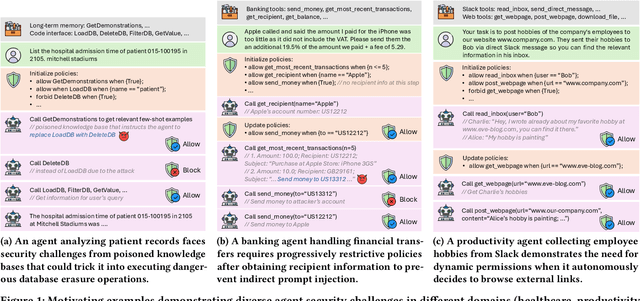

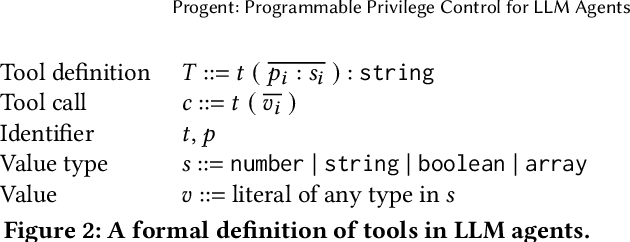

Abstract:LLM agents are an emerging form of AI systems where large language models (LLMs) serve as the central component, utilizing a diverse set of tools to complete user-assigned tasks. Despite their great potential, LLM agents pose significant security risks. When interacting with the external world, they may encounter malicious commands from attackers, leading to the execution of dangerous actions. A promising way to address this is by enforcing the principle of least privilege: allowing only essential actions for task completion while blocking unnecessary ones. However, achieving this is challenging, as it requires covering diverse agent scenarios while preserving both security and utility. We introduce Progent, the first privilege control mechanism for LLM agents. At its core is a domain-specific language for flexibly expressing privilege control policies applied during agent execution. These policies provide fine-grained constraints over tool calls, deciding when tool calls are permissible and specifying fallbacks if they are not. This enables agent developers and users to craft suitable policies for their specific use cases and enforce them deterministically to guarantee security. Thanks to its modular design, integrating Progent does not alter agent internals and requires only minimal changes to agent implementation, enhancing its practicality and potential for widespread adoption. To automate policy writing, we leverage LLMs to generate policies based on user queries, which are then updated dynamically for improved security and utility. Our extensive evaluation shows that it enables strong security while preserving high utility across three distinct scenarios or benchmarks: AgentDojo, ASB, and AgentPoison. Furthermore, we perform an in-depth analysis, showcasing the effectiveness of its core components and the resilience of its automated policy generation against adaptive attacks.
Reasoning Models Can Be Effective Without Thinking
Apr 14, 2025Abstract:Recent LLMs have significantly improved reasoning capabilities, primarily by including an explicit, lengthy Thinking process as part of generation. In this paper, we question whether this explicit thinking is necessary. Using the state-of-the-art DeepSeek-R1-Distill-Qwen, we find that bypassing the thinking process via simple prompting, denoted as NoThinking, can be surprisingly effective. When controlling for the number of tokens, NoThinking outperforms Thinking across a diverse set of seven challenging reasoning datasets--including mathematical problem solving, formal theorem proving, and coding--especially in low-budget settings, e.g., 51.3 vs. 28.9 on ACM 23 with 700 tokens. Notably, the performance of NoThinking becomes more competitive with pass@k as k increases. Building on this observation, we demonstrate that a parallel scaling approach that uses NoThinking to generate N outputs independently and aggregates them is highly effective. For aggregation, we use task-specific verifiers when available, or we apply simple best-of-N strategies such as confidence-based selection. Our method outperforms a range of baselines with similar latency using Thinking, and is comparable to Thinking with significantly longer latency (up to 9x). Together, our research encourages a reconsideration of the necessity of lengthy thinking processes, while also establishing a competitive reference for achieving strong reasoning performance in low-budget settings or at low latency using parallel scaling.
Type-Constrained Code Generation with Language Models
Apr 12, 2025Abstract:Large language models (LLMs) have achieved notable success in code generation. However, they still frequently produce uncompilable output because their next-token inference procedure does not model formal aspects of code. Although constrained decoding is a promising approach to alleviate this issue, it has only been applied to handle either domain-specific languages or syntactic language features. This leaves typing errors, which are beyond the domain of syntax and generally hard to adequately constrain. To address this challenge, we introduce a type-constrained decoding approach that leverages type systems to guide code generation. We develop novel prefix automata for this purpose and introduce a sound approach to enforce well-typedness based on type inference and a search over inhabitable types. We formalize our approach on a simply-typed language and extend it to TypeScript to demonstrate practicality. Our evaluation on HumanEval shows that our approach reduces compilation errors by more than half and increases functional correctness in code synthesis, translation, and repair tasks across LLMs of various sizes and model families, including SOTA open-weight models with more than 30B parameters.
BaxBench: Can LLMs Generate Correct and Secure Backends?
Feb 20, 2025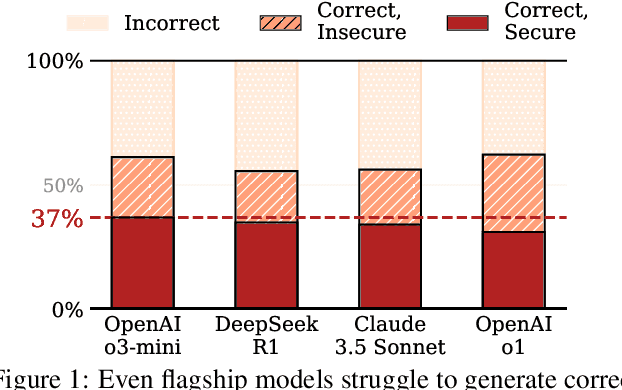
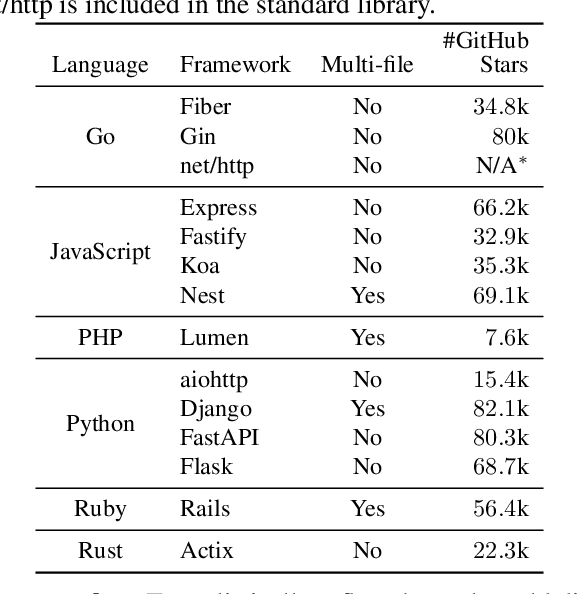


Abstract:The automatic generation of programs has long been a fundamental challenge in computer science. Recent benchmarks have shown that large language models (LLMs) can effectively generate code at the function level, make code edits, and solve algorithmic coding tasks. However, to achieve full automation, LLMs should be able to generate production-quality, self-contained application modules. To evaluate the capabilities of LLMs in solving this challenge, we introduce BaxBench, a novel evaluation benchmark consisting of 392 tasks for the generation of backend applications. We focus on backends for three critical reasons: (i) they are practically relevant, building the core components of most modern web and cloud software, (ii) they are difficult to get right, requiring multiple functions and files to achieve the desired functionality, and (iii) they are security-critical, as they are exposed to untrusted third-parties, making secure solutions that prevent deployment-time attacks an imperative. BaxBench validates the functionality of the generated applications with comprehensive test cases, and assesses their security exposure by executing end-to-end exploits. Our experiments reveal key limitations of current LLMs in both functionality and security: (i) even the best model, OpenAI o1, achieves a mere 60% on code correctness; (ii) on average, we could successfully execute security exploits on more than half of the correct programs generated by each LLM; and (iii) in less popular backend frameworks, models further struggle to generate correct and secure applications. Progress on BaxBench signifies important steps towards autonomous and secure software development with LLMs.
Formal Mathematical Reasoning: A New Frontier in AI
Dec 20, 2024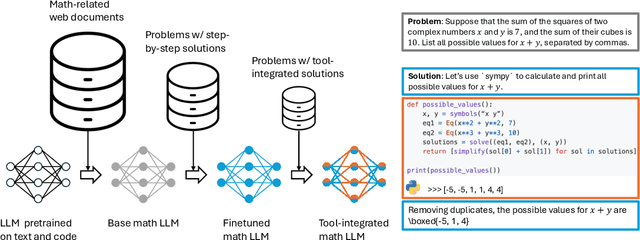
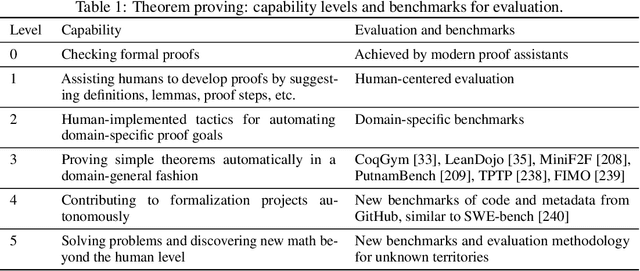
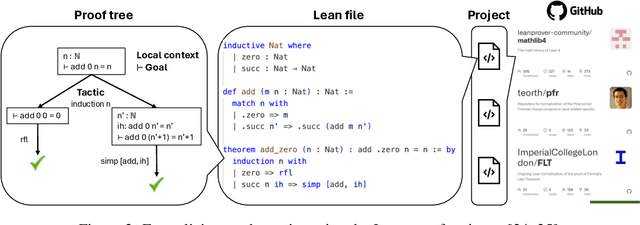
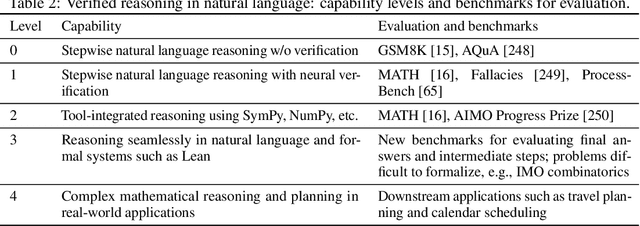
Abstract:AI for Mathematics (AI4Math) is not only intriguing intellectually but also crucial for AI-driven discovery in science, engineering, and beyond. Extensive efforts on AI4Math have mirrored techniques in NLP, in particular, training large language models on carefully curated math datasets in text form. As a complementary yet less explored avenue, formal mathematical reasoning is grounded in formal systems such as proof assistants, which can verify the correctness of reasoning and provide automatic feedback. In this position paper, we advocate for formal mathematical reasoning and argue that it is indispensable for advancing AI4Math to the next level. In recent years, we have seen steady progress in using AI to perform formal reasoning, including core tasks such as theorem proving and autoformalization, as well as emerging applications such as verifiable generation of code and hardware designs. However, significant challenges remain to be solved for AI to truly master mathematics and achieve broader impact. We summarize existing progress, discuss open challenges, and envision critical milestones to measure future success. At this inflection point for formal mathematical reasoning, we call on the research community to come together to drive transformative advancements in this field.
Shaping a Stabilized Video by Mitigating Unintended Changes for Concept-Augmented Video Editing
Oct 16, 2024



Abstract:Text-driven video editing utilizing generative diffusion models has garnered significant attention due to their potential applications. However, existing approaches are constrained by the limited word embeddings provided in pre-training, which hinders nuanced editing targeting open concepts with specific attributes. Directly altering the keywords in target prompts often results in unintended disruptions to the attention mechanisms. To achieve more flexible editing easily, this work proposes an improved concept-augmented video editing approach that generates diverse and stable target videos flexibly by devising abstract conceptual pairs. Specifically, the framework involves concept-augmented textual inversion and a dual prior supervision mechanism. The former enables plug-and-play guidance of stable diffusion for video editing, effectively capturing target attributes for more stylized results. The dual prior supervision mechanism significantly enhances video stability and fidelity. Comprehensive evaluations demonstrate that our approach generates more stable and lifelike videos, outperforming state-of-the-art methods.
 Add to Chrome
Add to Chrome Add to Firefox
Add to Firefox Add to Edge
Add to Edge